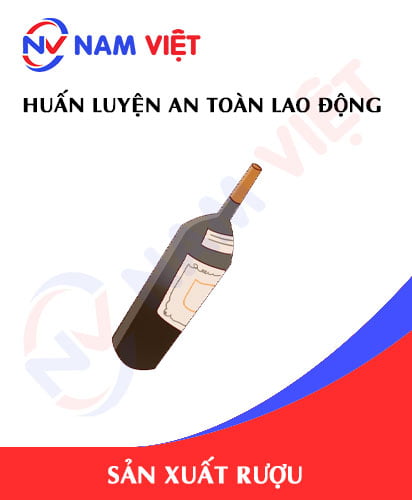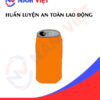Occupational Safety Training in Alcohol Manufacturing
99,000 ₫
Note: The above price is calculated for one person, the price may fluctuate depending on the number of trainees participating in the course and the dynamics of the market. For more accurate price support, please refer to the quotation table or contact our consulting staff directly.
Occupational safety is an important issue in alcohol manufacturing factories and needs to be addressed promptly to ensure the health and safety of workers, as well as to enhance the reputation of businesses. The Occupational safety training course is one of the effective solutions to raise awareness of accident prevention for workers participating in alcohol production.
Table of Contents
Toggle1. Overview of Alcohol
a. What is Alcohol?
- Alcohol is an alcoholic beverage produced from various types of fruits, grains, or potatoes. The manufacturing process includes fermenting sugars from fruits or grains, followed by distillation to extract alcohol. Alcohol can be consumed directly or used in many dishes and beverages. However, excessive consumption of alcohol can harm health, so it should be used with caution and moderation.
- The alcohol manufacturing industry in Vietnam is considered to have great potential and contributes significantly to the national economy. According to the Ministry of Industry and Trade, in recent years, alcohol production in Vietnam has tended to increase annually, especially for types of alcohol made from Vietnamese agricultural products such as sticky rice wine, mac khen wine, Dalat wine, sim wine, rice wine, grape wine, and honey wine.
- However, the alcohol manufacturing industry in Vietnam still faces many challenges, including competition with imported alcohol products, production of counterfeit and illegal alcohol that harms consumer health, and affects social order. Therefore, strict management, quality control, and food safety in alcohol manufacturing are extremely important.

b. Types of Alcohol Manufacturing Machinery
The types of machinery and equipment used in alcohol manufacturing include:
- Fruit crusher: used to crush fruits, separate pulp, and extract juice for alcohol.
- Fermentation tank: used to ferment alcohol for a few weeks to several months, helping develop alcohol content and flavor.
- Alcohol filter: used to remove impurities and ensure clarity of the alcohol.
- Mixing tank: used to blend ingredients such as fruits, spices, sugar, and water.
- Storage tanks: used to store and transport alcohol.
- Bottling machine: used for bottling alcohol, including capping machines, automatic bottling machines, etc.
Additionally, there are supporting devices such as filters, vacuum fermentation tanks, measuring tanks, and positioning tanks to ensure the alcohol manufacturing process is safe and produces high-quality products.

c. Alcohol Manufacturing Companies in Vietnam
In Vietnam, there are many alcohol manufacturing companies with various scales and brands. Some notable companies include:
- Hapro – Hanoi Liquor Joint Stock Company: the largest alcohol manufacturer in Hanoi, established in 1961. Hapro specializes in producing and trading famous types of alcohol such as Vodka, Rice Wine, and Fruit Wine.
- SABECO – Saigon Beer Alcohol Beverage Corporation: established in 1977, a leading alcohol and beer manufacturer in Vietnam. SABECO owns famous brands such as Saigon Beer, Vodka, and Rượu 333.
- Dalat Wine: an alcohol manufacturer specializing in high-quality wine, established in 2003. Dalat Wine produces and markets premium wines from the best grape varieties.
- Son Tinh: one of the largest traditional alcohol manufacturers in Vietnam, owning well-known brands such as Quoc Dan Wine, Te Thuy Wine, Com Wine, and Plum Wine.
- Diageo Vietnam: the largest international alcohol manufacturer in Vietnam, established in 1994, owning globally famous brands like Johnnie Walker, Smirnoff, and Baileys.
- Hanoi Liquor JSC: one of the largest alcohol manufacturing and trading companies in Vietnam, specializing in Vodka, Rice Wine, and Fruit Wine.
- Phu Loc – Thien Huong: a famous alcohol manufacturer in Hue, specializing in strong alcohol and wine.
- Song Lam Co., Ltd.: one of the largest traditional alcohol manufacturers in Vietnam, producing Honey Wine, Sticky Rice Wine, and Rice Wine.
d. Specific Jobs in an Alcohol Factory
Group 1
- CEO, Deputy CEO, Department Heads in an alcohol factory.
Group 2
- Safety Officer: managing safety in the factory, designing safety procedures, supervising and enforcing employee compliance with safe work procedures.
Group 3
- Raw material selection: Choosing the best grapes or ingredients for alcohol. The raw materials must be carefully checked for quality and safety.
- Crushing: After selection, grapes are crushed to extract juice.
- Fermentation: Fruit juice is sorted and fermented in a sealed tank for 2–3 weeks.
- Distillation: After fermentation, the juice is distilled to separate alcohol and essential oils.
- Wood barrel aging: Premium alcohol is stored in wooden barrels to absorb the wood flavor and achieve distinctive taste.
- Refinement: Alcohol is inspected and refined according to customer requirements for optimal quality and flavor.
- Bottling and packaging: After production, alcohol is bottled and packaged for sale.
Group 4
- Office, service, sales, and marketing work.
- Production management, quality management, human resources management, material management, financial accounting management.
- Research and development of new products, design of packaging.

2. Overview of Labor Safety Training in Alcohol Manufacturing
In this article, we focus on Group 3 because Group 3 directly participates in the manufacturing process and is exposed to the highest labor safety risks. See other groups here.
a. What is Group 3 Labor Safety Training?
- Group 3 labor safety training provides sessions to equip workers with awareness on how to prevent labor accidents.
- The training helps workers identify and avoid hazards, reducing the risk of labor accidents during work.
REGISTER FOR LABOR SAFETY TRAINING
b. Training Duration
Initial Safety Training Duration
- Total training time is at least 24 hours, including testing time.
- 8 hours of theory on policies and labor safety regulations.
- 8 hours of theory on basic occupational safety knowledge.
- 4 hours of theory on specialized training content.
- 2 hours of practical exercises on specialized training content.
- 2 hours of final theoretical testing at the end of the course.
The safety training center schedules multiple sessions depending on worker availability. Typically, there are 6 sessions over 3 days if the manufacturing company can arrange continuous study time.
Periodic Safety Training Duration
- Before the labor safety card expires, workers must undergo periodic labor safety training for at least 50% of the initial training duration.
Explanation: The total periodic labor safety training is at least 12 hours, including testing. Upon completion and passing the test, workers will be reissued or extended the labor safety card.
c. Training Content
| No. | TRAINING CONTENT | TRAINING DURATION (HOURS) | |||
| Total | Including | ||||
| Theory | Practice | Test | |||
| I | Policies and Labor Safety Laws | 8 | 8 | 0 | 0 |
| 1 | Overview of labor safety laws and regulations. | 6 | 6 | ||
| 2 | System of standards and technical regulations on labor safety. | 1 | 1 | ||
| 3 | Specific regulations by government authorities on safety when constructing, expanding, or renovating facilities, and on the use, storage, and inspection of machinery, equipment, materials, and substances requiring strict safety compliance. | 1 | 1 | ||
| II | Basic Knowledge of Occupational Safety | 8 | 8 | 0 | 0 |
| 1 | Basic knowledge of hazards and harmful factors in the workplace. | 4 | 4 | ||
| 2 | Methods to improve working conditions. | 1 | 1 | ||
| 3 | Safety culture in manufacturing and business operations. | 1 | 1 | ||
| 4 | Rights and obligations of employers and workers; policies on labor safety and hygiene; functions and responsibilities of the safety network. | 1 | 1 | ||
| 5 | Workplace safety rules, signs, and use of personal protective equipment; first aid and occupational disease prevention skills. | 1 | 1 | ||
| III | Specialized Training Content | 6 | 4 | 2 | 0 |
| Comprehensive knowledge of machinery, equipment, and substances causing hazards; risk analysis, safety management, and safe work procedures with machines and substances requiring strict safety compliance. | 6 | 4 | 2 | ||
| IV | Final Safety Training Assessment | 2 | 2 | 0 | 0 |
| Total | 24 | 22 | 2 | ||
See more training content of all 6 groups
d. Labor Safety Card
After completing the labor safety training and passing the test, workers will be issued a labor safety card (commonly called Group 3 labor safety certificate).
The Group 3 safety card displays information such as name, date of birth, specific job and work environment, training duration, official seal, and signature confirming course completion.
According to regulations on issuing safety cards in Clause 2 of Article 24, Decree 44/2016/ND-CP, there are two cases:
- If the employer and employee have a labor contract, the employer must sign, stamp, and seal the safety card for Group 3 trainees after they complete the labor safety course from a certified training unit and pass the test.
- If the worker is freelance or seasonal with no labor contract, the training unit must sign, stamp, and seal the safety card after the worker completes the labor safety course and passes the test.

3. Identifying Hazards Affecting Workers in Wine Manufacturing
Hazards affecting workers in wine manufacturing may include:
- During wine manufacturing, chemicals such as ethylene glycol, methanol, and sulfuric acid may be used to produce high-quality products. However, if not used properly, these chemicals can cause health problems for workers, including headaches, fatigue, dizziness, and difficulty breathing.
- Wine factories may have complex equipment such as distillation machines and cooling systems. If not used properly or maintained regularly, these devices can create safety hazards such as explosions or fires.
- Wine manufacturing requires high humidity and temperature. Workers must work in hot and humid environments, causing discomfort and fatigue. If unaddressed, health issues may include headaches, fever, and difficulty breathing.
- Wine factories may have dangerous machinery and equipment such as crushers, presses, and pressurized tanks. If not used properly or maintained regularly, these machines can cause serious occupational accidents for workers.
- If electrical equipment in the factory is not regularly maintained, insulated, or waterproofed, it can pose the risk of electric shock for workers during manufacturing.
4. Common Occupational Accidents in Wine Manufacturing
Common occupational accidents for workers in wine manufacturing may include:
- Chemical accidents: Workers may be directly exposed to or inhale chemicals such as ethanol, methanol, and acetaldehyde, which play a key role in wine manufacturing. If not handled properly or without full protective equipment, these chemicals can pose serious health risks and sometimes be fatal.
- Physical accidents: Physical hazards, such as bottling, packaging, and using wine manufacturing machinery, can cause injuries or accidents. Workers must be properly trained and use protective equipment to reduce physical accidents.
- Transport accidents: During the transportation of wine products, workers may encounter traffic accidents, such as vehicle collisions or accidents when loading and unloading. This is especially true for wine transported in heavy wooden barrels.
- Fire and explosion accidents: Wine manufacturing often uses heating equipment, such as boilers, distillation machines, and steam kettles. Improper use of these devices can lead to serious fire or explosion accidents.
- Other occupational accidents: Wine manufacturing involves multiple activities, such as bottling, packaging, and transporting products. These activities can lead to other occupational accidents, such as sprains, collisions, and slips or falls.

5. Safety Measures in Wine Manufacturing
Safety measures in wine manufacturing include:
- Wear full personal protective equipment, including helmets, safety shoes, safety goggles, and gloves, to protect hands, body, and head during all stages of manufacturing.
- Ensure proper ventilation in the workspace to minimize accumulation of alcohol vapor, toxic gases, and pressure.
- Follow proper manufacturing procedures, complying with safety regulations regarding electricity, gas systems, and heating systems.
- Use verified safe chemicals and flavorings to ensure they do not harm consumer health.
- Control the manufacturing process to prevent incidents and ensure the safety of both staff and products.
- Train employees on manufacturing techniques, equipment and chemical usage, and accident prevention to improve workers’ safety knowledge and skills.
- Ensure food safety and hygiene by following environmental sanitation regulations, isolating manufacturing areas, and protecting consumer health.
- Conduct periodic inspections and maintenance of machinery, systems, and transportation means to ensure safe usage.
- Develop fire and explosion prevention plans to minimize damage in case of accidents.
- Investigate, analyze, and report incidents and accidents to implement corrective measures and prevent recurrence.
- Regularly perform occupational environment monitoring in factories, collect and analyze harmful factors for workers, and adjust to reduce risks to prevent occupational diseases.
6. Benefits of Wine Manufacturing Safety Training
An Toan Nam Viet provides businesses with the following benefits after completing occupational safety training in accordance with Decree 44/2016/ND-CP on occupational safety and hygiene:
- Workers can identify potential hazards and take preventive measures to avoid accidents.
- Businesses can establish risk prevention measures in production, operation, and maintenance processes.
- Reduce costs associated with occupational safety incidents.
- Uninterrupted production increases labor productivity and product quality.
- Comply with labor safety laws and avoid legal risks.
- Enhance corporate reputation and professionalism, boosting the business brand.
Nam Viet’s training programs provide solutions to prevent external hazards that may cause injuries or, in severe cases, death.
REGISTER FOR OCCUPATIONAL SAFETY TRAINING
7. Customer Feedback After Completing Wine Manufacturing Safety Training
An Toan Nam Viet has many years of experience accompanying businesses in Vietnam in general and in southern provinces in particular. This responsibility is extremely valuable to Nam Viet, so our Occupational Safety Training is increasingly professional. The motivation for An Toan Nam Viet’s growth comes from positive feedback and suggestions from partner businesses. Below are feedbacks from our clients.
Bac Nam E&C Construction Investment Joint Stock Company
“The first time using services at An Toan Nam Viet, I was impressed by the 24/7 support from the consulting team. The class organization was quick and convenient for our company. Thank you very much for Nam Viet’s service!”
Hoa Dat Construction and Trading Joint Stock Company
“Nam Viet’s service has greatly helped us simplify occupational safety and complete safety documentation for the working process. The consulting team is enthusiastic and timely in answering our questions. Five stars for Nam Viet.”
See more customer interviews after using services of An Toan Nam Viet
8. An Toan Nam Viet’s Capacity in Occupational Safety Training
An Toan Nam Viet is a reputable and high-quality center for occupational safety training in Vietnam today. Our safety training sessions take place continuously at factories, manufacturing workshops, or construction sites across the country (all 63 provinces of Vietnam).
REGISTER FOR OCCUPATIONAL SAFETY TRAINING
Occupational Safety Training License
- An Toan Nam Viet has been inspected and certified by the Department of Occupational Safety, Ministry of Labor, Invalids and Social Affairs and granted the certificate of eligibility for occupational safety and hygiene training. This further strengthens our occupational safety training capabilities.

Materials and Lectures
- Before safety training materials are used in ATLĐ training courses, they are reviewed and approved to ensure accuracy and effectiveness when applied.
- Instructors’ teaching methods follow the standards of An Toan Nam Viet, which have been researched and developed by occupational safety experts to maximize knowledge absorption for trainees.
Facilities
- Controlling classroom factors that affect the training process increases teaching efficiency and trainee knowledge absorption.
- Our training support facilities always provide spacious classrooms meeting area, lighting, and training equipment standards.
9. Nationwide Reputable and Quality Safety Training Center
At An Toan Nam Viet, we always prioritize our professional dedication to occupational safety training. For us, imparting knowledge on self-protection to workers, equipping them with safety skills for their livelihoods, is also a contribution to national development.
To ensure effective training, we carefully and meticulously prepare every detail, no matter how small. From preparing tools, teaching equipment, and materials to manuals, audio, and lighting.
Our occupational safety training instructors are experts with many years of experience in the field. They even have research works identifying hazards across industries and methods to prevent them.
The lectures are derived from practical experience and delivered in a lively, easy-to-understand manner for workers. These factors help workers feel comfortable during training and effectively absorb the knowledge we teach. Of course, the content always adheres closely to Decree 44/2016/ND-CP.
From this, workers learn multiple hazard prevention measures and ways to protect themselves. They can also apply these measures appropriately in real work situations.
Our Safety Training Center proudly provides reputable and professional occupational safety training services with the following advantages:
- Competitive training costs while maintaining high training quality.
- Flexible training schedule according to the production needs of companies.
- Fast certification procedures for occupational safety training in compliance with the law.
- Instructors with extensive experience in the profession.
- Classrooms controlled for factors affecting the training process, enhancing teaching efficiency and knowledge absorption.
- Lectures designed to suit occupational safety tasks in enterprises.
- An Toan Nam Viet works dedicatedly and professionally to provide clients with accurate and fast support.

10. Additional References for Wine Manufacturing Safety Training Materials
- Wine Manufacturing Occupational Safety Materials
- Full Set of Occupational Safety Training Materials
- Occupational Safety Training Exam Set
- Wine Manufacturing Occupational Safety Quiz
- Wine Manufacturing Safety Training Slides
1 review for Occupational Safety Training in Alcohol Manufacturing
No comments yet















namchinh.haiphong341
Hài lòng nhé!